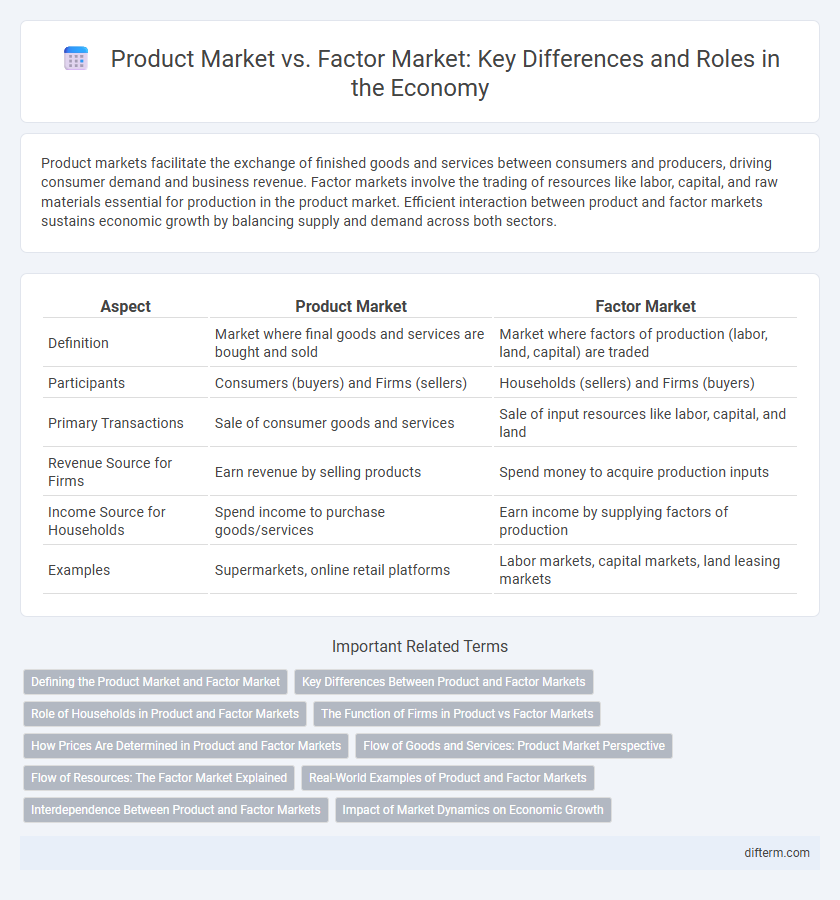Product markets facilitate the exchange of finished goods and services between consumers and producers, driving consumer demand and business revenue. Factor markets involve the trading of resources like labor, capital, and raw materials essential for production in the product market. Efficient interaction between product and factor markets sustains economic growth by balancing supply and demand across both sectors.
Table of Comparison
| Aspect | Product Market | Factor Market |
|---|---|---|
| Definition | Market where final goods and services are bought and sold | Market where factors of production (labor, land, capital) are traded |
| Participants | Consumers (buyers) and Firms (sellers) | Households (sellers) and Firms (buyers) |
| Primary Transactions | Sale of consumer goods and services | Sale of input resources like labor, capital, and land |
| Revenue Source for Firms | Earn revenue by selling products | Spend money to acquire production inputs |
| Income Source for Households | Spend income to purchase goods/services | Earn income by supplying factors of production |
| Examples | Supermarkets, online retail platforms | Labor markets, capital markets, land leasing markets |
Defining the Product Market and Factor Market
The product market involves the buying and selling of finished goods and services, where consumers and firms exchange outputs for money. The factor market, in contrast, deals with the trade of inputs or factors of production such as labor, capital, and land, enabling firms to acquire resources necessary for production. Understanding the distinction between these markets is crucial for analyzing economic flows and resource allocation.
Key Differences Between Product and Factor Markets
Product markets involve the buying and selling of finished goods and services directly to consumers, whereas factor markets deal with the exchange of inputs like labor, capital, and raw materials needed for production. Prices in product markets are determined by consumer demand for goods, while factor market prices depend on the supply and demand of resources such as wages for labor or rent for land. The product market primarily serves households as consumers, and factor markets primarily serve firms as buyers of production inputs.
Role of Households in Product and Factor Markets
Households play a dual role in the economy by acting as consumers in the product market and as suppliers in the factor market. In the product market, they purchase goods and services to satisfy their needs and preferences, driving demand and influencing prices. In the factor market, households provide labor, capital, land, and entrepreneurship, earning income which they use to participate in the product market again, creating a continuous economic cycle.
The Function of Firms in Product vs Factor Markets
Firms act as buyers in factor markets, acquiring inputs such as labor, capital, and raw materials essential for production. In product markets, firms function as sellers, offering finished goods and services to consumers and other businesses. This dual role integrates resource allocation and product distribution, driving economic activity and efficiency.
How Prices Are Determined in Product and Factor Markets
Prices in product markets are determined primarily by the interaction of supply and demand for finished goods and services, where consumers' willingness to pay meets producers' costs and profit margins. In factor markets, prices are set through the negotiation between firms and owners of production inputs such as labor, land, and capital, reflecting the marginal productivity and scarcity of these resources. Market equilibrium prices adjust continuously to balance quantity supplied and demanded in both product and factor markets, thereby coordinating resource allocation and production output.
Flow of Goods and Services: Product Market Perspective
The product market facilitates the flow of goods and services from businesses to consumers, where finished products are sold for final consumption. Firms supply tangible goods and intangible services, generating revenue by meeting consumer demand in retail, wholesale, and online platforms. This market drives economic activity by enabling consumer spending, influencing production levels, and determining price signals.
Flow of Resources: The Factor Market Explained
The factor market facilitates the flow of resources such as labor, capital, and land from households to firms, enabling production processes to occur. Households supply these factors of production in exchange for income, including wages, rent, and profits, which drives economic activity. Efficient functioning of the factor market ensures optimal allocation of resources, directly impacting productivity and overall economic growth.
Real-World Examples of Product and Factor Markets
Product markets involve the buying and selling of finished goods and services, exemplified by retail stores like Walmart or e-commerce platforms such as Amazon where consumers purchase products. Factor markets deal with the trade of production inputs including labor, land, and capital, represented by labor markets where companies hire employees, or capital markets where businesses obtain funding through stocks and bonds. Real-world instances include the technology sector's product market with smartphones, and the labor factor market where tech firms recruit software engineers.
Interdependence Between Product and Factor Markets
The interdependence between product and factor markets is fundamental to economic equilibrium, where factor markets supply resources such as labor and capital needed for production in product markets. Firms demand factors of production to create goods and services that households purchase in product markets, creating a circular flow of income. Changes in wages, rent, or profits in factor markets directly impact supply and demand dynamics within product markets, highlighting their continuous interaction.
Impact of Market Dynamics on Economic Growth
Product markets drive economic growth by facilitating the efficient exchange of goods and services, stimulating consumer demand and innovation. Factor markets allocate resources like labor, capital, and land, influencing productivity and the overall supply capacity of an economy. Dynamic interactions between product and factor markets optimize resource distribution, enhance technological advancement, and boost national income levels.
Product Market vs Factor Market Infographic

 difterm.com
difterm.com